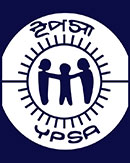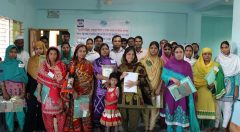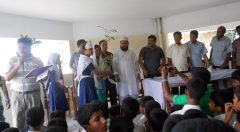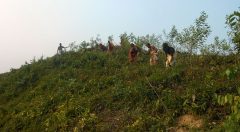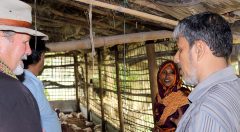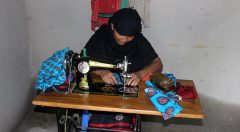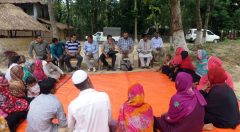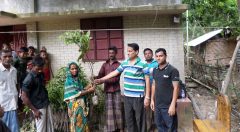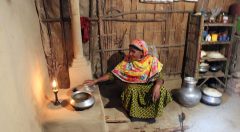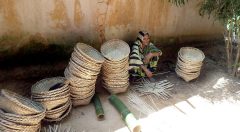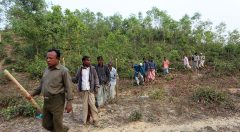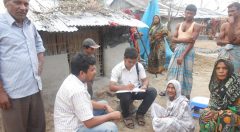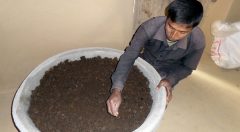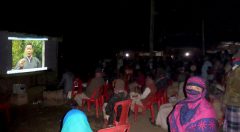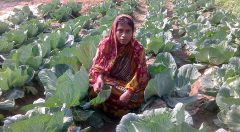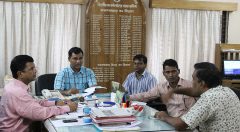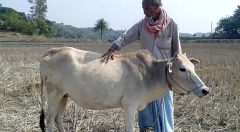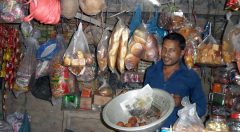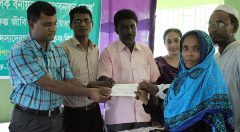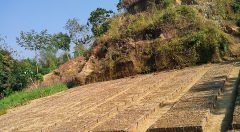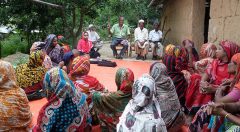Photo Gallery
Project title: Climate Resilient Participatory Afforestation and Reforestation Project (CRPARP), Component-2: Alternative Livelihoods to Support Forest Communities (ALSFC).
Introduction
Arannayk foundation has signed a MOU with YPSA for implementation of Component-2: Alternative Livelihoods to Support Forest Communities (ALSFC).under BCCRF and World Bank supported Climate Resilient Participatory Afforestation and Reforestation Project (CRPARP). The development objective of the project is to improve the resilience of selected communities in the coastal and hilly areas of Bangladesh by (i) increasing the size of afforested and reforested areas; (ii) strengthening alternative livelihoods of forest-dependent communities; and (iii) improving the institutional capacity of the forest department to sustainably manage forest resources. The project implementation areas are two costal and hilly districts namely Chittagong and Cox’sbazar of South-East Bangladesh. YPSA has prepared this project document on the basis of field realities and focusing on the project objectives as well as goal. This project document has prepared with the concern of AF, which includes the specific/ indentified project area and location, implementing methodology, logical frame work, the roles and responsibility of project staffs and an estimated budget.
Background & Rationale
People of surrounding forest areas of the coastal belt under Chittagong and Cox’s Bazara districts are poor and landless; they maintain their livelihood by collecting forest product like bamboo, fuel wood, and some other forest products. Their dependency on forest causes over exploitation and forest lost its biodiversity day by day and forest and plantations are under pressure. So the communities have been affected by climate change impacts (loss of lives, assets, livelihood, outmigration from the area, etc.) caused by cyclones, storm surges, river erosion, and sea level rise in the selected coastal regions. Bangladesh government had a huge no of plantation program at coastal area but tree from the plantation areas has been reduced due to conservation of land and forest dependency of the community people. Due to lack of capital, most of the forest dependent people could not involve with any alternative activities to maintain their daily life and improve their livelihood. So the local people cultivate different agricultural crops in this area and use forest products such as wood as fuel or sell it to earn an income. So YPSA is intend to implement a project on Alternative Livelihoods to Support to Forest Communities in 5 forest divisions in Chittagong and Cox’s Bazar coastal and hilly areas where plantation activities will be carried out by Forest department.
It has been proved that capital of alternative income generating activities for forest dependent people is an effective strategy for livelihood improvement and poverty reduction among the forest dependent people. And alternative livelihood is closely linked to afforestation/reforestation and target the communities/villages located in the coastal forests in the 2 districts that are highly vulnerable to climate change effect. Through improving livelihood opportunities, it is expected that pressure on the forests will be reduce which contribute to sustainable use, conservation and protection of forest resulting to reduce climate change effect.
The project will facilitate to mobilize the poor forest dependent households into groups, engage them in afforestation and reforestation activities, provide them with relevant training, as well as technical and financial support to improve their livelihoods. So YPSA wants to achieve following objectives through the project.
Objective of the project
- To reduce forest dependency among the community people through improving non-forest based livelihood opportunities for the communities and groups living in and around the forests and plantation areas.
- To promote sustainable institutional development of the forest dependent people through capacity development and building awareness.
- To contribute to the sustainable use, conservation and protection of forest for reducing climate change effect through the active participation of the communities in Chittagong and Cox’s Bazar.
Location and area
The project has been implementing in two Climate Vulnerable Coastal and Hilly district of South-Eastern Bangladesh namely Chittagong and Cox’sbazar. YPSA has covered forest (Afforestation/ reforestation) adjacent 120 Forest Dependent Villages (FDG’s) of 33 Union from 16 Upazilla’s under 5 Forest Division namely Chittagong South, Chittagong North, Chittagong Coastal, Cox’sbazar South and Cox’sbazar North Forest Division. The covered union’s are Korerhat, Ichakhali and Mogadia under Mirsharai; Datmara, Harualchori and Narayanhat under Fatikchori; Moghdhara under Sandwip; Mirzapur under Hathazari; Padua and Sarofvata under Rangunia; Salimpur under Sitakund; Bajalia, Purangor, Madarsha and Aocia Under Satkania; Baharchara under Banskhali; Toitong and Barabakia under Pekua; Chunati under Lohagara; Harbang and Surejpur-Manikpur under Chokoria; Eidgaon and Islampur under Cox’sbazar Sadar; Rashidnagar, Joarianala, Koccopia, Rajarkul, South Mithachori and Khuniapalong under Ramu; Saplapur and Hoyanok under Moheshkhali; Haludiapalong under Ukhia and Whykheong under Teknaf Upazila respectively.
From the said 33 unions YPSA has covered 120 FDGs where each FDG hold 30 Climate vulnerable highly forest dependent poor and hardcore poor families. In this way YPSA has covered 3600 forest dependent HH from 120 FDG’s of 33 union under 16 Upazila. The working FDGs are lying under 50 Forest Beat of 34 Forest range under said 5 Forest Division.
Role and responsibilities in Project Implementation
YPSA has established 5 project site offices at Fatikchori, Chittagong, Lohagara, Cox’sbazar and Ukhia Site. Each Site Office consisting about 20 or above FDG’s. In each of the selected villages, the YPSA has organize a group of about 30 poorest and most forest dependent households to conduct the capacity building and alternative livelihood development activities of the ALSFC component. YPSA has been implementing the specific responsibilities are:
- Establishment of site offices for the ALSFC component of the project
- Selection and orientation of community volunteers (Village Facilitators)
- Selection of project villages, using the criteria and process
- Selection of project participants using the WB agreed criteria and process
- Formation of Forest Dependent Groups (FDG)
- Formation of Union Forest Conservation Forum (UFCF)
- Formation of Union-level federations of the FDGs
- Conducting awareness campaign on climate change, tree planting/afforestation and forest conservation at Village, Union, Upazila and district level
- Organizing training and exchange visits for the members of FDGs and their Union-level federations for their technical (AIGA, forest conservation), organizational and management skills development
- Establishment of Mutual Rotating Savings and Loan Funds (MRSLF) at the Union-level federations of the FDG
- Providing continuous backstopping and accompaniment support to the FDGs and their Union federations in their participatory development activities
- Facilitation of linkage development between the FDGs, VCFs with local government bodies (Union Parishadand Upazila Parishad), government line agencies and relevant private sector organizations including markets)
- Baseline survey and subsequent monitoring activities
- Proving guidance and accompaniment support to the FDGs in developing and implementing the participatory monitoring system
- Close coordination with concern field and regional/ district level forest department personnel
Staffing of Project
A group of skill manpower has been deployed to implement the ALSFC component of CRPARP project. YPSA has deployed Project Manager (PM)-1, Training & Monitoring Officer (TMO) -1, Regional Finance & Admin Officer (FAO) – 1, Site Coordinator (SC)- 5, Field Facilitator (FF)- 13, Field Facilitator (Value Chain)- 3, Site Accounts Officer – 4, Project Support Staff (SS) -4 and paid Community Organizing volunteer – 120 for implementing the project activity.
Strategies/ Methodology
Site Selection for AIGA Program: Criteria and Process
The project has been continuing in the selected areas of 2 coastal districts in south-east region of Bangladesh. These coastal districts are Cox’s Bazar, Chittagong. In the hilly area, the project will target the core and buffer zones of the Reserved Forest land of two districts. These are included as coastal districts also. Five Forest Divisions has been covered under the project are Chittagong Coastal Afforestation Division, Chittagong North Forest Division, Chittagong South Forest Division, Cox’s Bazar North Forest Division and Cox’s Bazar South Forest Division.
The Component-1 of the project is aimed at afforestation/ reforestation of 17,000 ha of land in hilly and coastal districts. Afforestation/reforestation sites will be selected by the BFD and its Divisional Forest Offices (DFO). The ALSFC will target the same areas. However, due to available resources, the numbers of target villages are 120, with 3,600 participant’s households. To ensure full community participation in project activities, the project will engage community volunteers as village facilitators.
The 120 villages has been selected based on several criteria such as proximity to proposed afforestation/ reforestation site, proximity to natural forest, level of current and potential impacts of climate change, size of area to be afforestated/ reforestated, and level of poverty. The villages within 5-6 km distance around each of the selected afforesation/reforestation site shall be ranked based on the scoring system presented in the table below;
Table -Criteria for village selection for the ALSFC component
| Crieria | Definition | Score | |
| 1 | Proximity to proposed afforestation/reforestation site | 0 – 2 km | 3 |
| 2 – 4 km | 2 | ||
| 4 – 5 km | 1 | ||
| > 5 km | 0 | ||
| 2 | Proximity to natural forest (important indicator for defining forest dependent communities) | 0 – 2 km | 3 |
| 2 – 4 km | 2 | ||
| 4 – 5 km | 1 | ||
| > 5 km | 0 | ||
| 3 | Level of current and potential impacts of climate change (occurrence of soil erosion/landslide, water retention, probability of tidal surges, salinity) | Very high | 4 |
| High | 3 | ||
| Medium | 2 | ||
| Low | 1 | ||
| 4 | Size of area to be afforestated/reforestated (the minimum size should not be less than 10 ha to include 30 beneficiaries for ALSFC component) | > 50 ha | 3 |
| 20 – 40 ha | 2 | ||
| 10 – 20 ha | 1 | ||
| <10 ha | 0 | ||
| 5 | Level of poverty (based on the most updated statistical data such as Poverty Map of Bangladesh of 2009 and Union Parishad data on village poverty level) | Very high | 4 |
| High | 3 | ||
| Moderate | 2 | ||
| Low | 1 | ||
| Total score | (Sum of all scores) |
Selection of Beneficiaries: Criteria and Process
The primary direct participants of the ALFSC are poor, vulnerable and marginalized households highly depending on forest resources for their livelihoods. In this way YPSA has selected 3,600 households comprising not less than 15,000 people in 120 villages. All eligibility/selection criteria, such as poverty and well being level, marginalization either by gender, by ethnicity or social status, dependency on forest resources has been quantified and scored. Single women led households has given priority. About 78% FDGs participants are women.
Secondary participants of the project are populations that benefit from improved afforestation and reforestation efforts, both in improving the sustainability of forests in the area, but also in protection of critical ecosystems that help to improve resilience. Half of the participants are expected to be women.
The detailed criteria and scoring system that has been used to select the participants of the ALSFC component are presented in the following table.
Table -Criteria for beneficiaries’ selection for the ALSFC component
| Criteria | Definition | Score | |
| 1 | Demographic/social | Indigenous people household | 3 |
| women headed household | 4 | ||
| disabled/vulnerable women headed household | 4 | ||
| Neither of above | 0 | ||
| 2 | Household income per person (using monthly household expenditures as a proxy) | More than 1,500 taka and less than 3,000 taka | 1 |
| 800-1500 | 2 | ||
| Less than 800 taka | 3 | ||
| More than 3,000 taka | 0 | ||
| 3 | Homestead land | Owned | 1 |
| Encroached or belongs to relatives | 2 | ||
| Leased land | 3 | ||
| Have other land as well | 0 | ||
| 4 | Housing | Permanent (wood, pacca) | 1 |
| Semi temporary (made of bamboo or wood with tin roof and semi-pucca floor) | 2 | ||
| Temporary (made of mud, bamboo or palm leaf with kacha floor) | 3 | ||
| Wood, brick | 0 | ||
| 5 | Access to drinking water | From tube well | 1 |
| From pond | 2 | ||
| From other unstable sources | 3 | ||
| Have own water supply | 0 | ||
| 6 | Sanitary facilities | Permanent latrine | 1 |
| Temporary latrine | 2 | ||
| No latrine | 3 | ||
| Have full scale toilet | 0 | ||
| 7 | Household assets (the value of a set of the most important assets, including land, livestock, productive assets, appliances, and non-productive assets | More than 2 mln taka | 1 |
| 1-2 million taka | 2 | ||
| Less than 1mln taka | 3 | ||
| More than 3 mln taka | 0 | ||
| 8 | Forest dependency (% of household income from forest) | More than 50% | 2 |
| More than 70% | 4 | ||
| 90-100% | 6 | ||
| Less than 50% | 0 | ||
| Total Score | (Sum of all scores) |
The selection process will include the following major steps:
- Village meeting with dissemination of information about Project, its objectives and processes, information about selection process and criteria
- Collect poverty data of village HH from the local government for data triangulation
- Conducted Focus Group Discussions with local authorities and leaders (Forest Beat Officer, Union Parishad Secretary, representatives of local social leaders to: (1) inform them about the Project, objectives and processes, (2) identify closest to forest segments of village through participatory mapping and 3) to verified/modified where needed eligibility ranking system and weighing for each specific village to reflect real situation, (3) to identify obvious households eligible for ALSFC
- PRA in selected segments of the village closest to the forest with participatory wealth ranking exercise and identification of poor forest dependent households.
- Verification of selected households through the beneficiaries’ eligibility weighing system
- Undertaking baseline survey of the household
- Affirmation of list of selected households at the village meeting.
The list of the selected participants included number of people required for the SF program in that locality. However, only 30 households who scored highest in the weighing system and affirmed by village meeting and finally selected for ALSFC component.
Group Development
YPSA has selected poor and marginalized households into village level Forest Dependant Groups (FDGs). Each FGD has formed with 30 members and the list of selected members. Afterwards YPSA has formed Union Forest Conservation Forum (UFCF), which fromed by FDGs and local elite, such as representatives of local government, religious leaders, Forest Beat officers, directors of schools, and other informal community leaders. Establishing UFCF gives a broader platform for representation. UFCF has been conducting quarterly meetings, where they will discuss issues related to climate change, forest conservation and undergoing livelihood activities.
A number of 16 Forest Patrolling Group (CPG) has formed with 21 members in each by the member of Union Federation. CFP has been working closely with Forest Beat Officers in roster basis for the conservation of Forest. On the other hand 33 Union Federation has formed by the FDGs representatives to formalize their status (as registered community-based organization) and link to local government support.
Capacity Development of the Community Based Organizations
YPSA with the support from the AF prepared and organized training programs on aspects of (a) organizational development and management and (b) livelihood development for the FDG and Union federation members and (c) forest conservation and climate change adaptation for both FDG and UFCF members.
Livelihood Development
Two-tranche Approach
The AIGAs will be developed in two windows/tranches: (i) small scale livelihood activities at the household level (e.g. goat and poultry rearing, vegetable cultivation, small scale trade) and (ii) value adding economic activities at the community level (e.g. cooperative marketing of local products, community based eco-tourism, commercial agricultural farming and manufacturing of energy efficient cooking stoves).
Small-scale Livelihood Activities: Activity Selection and Support Provisions
The project has been providing training and MRSLF loan support for AIGAs to the poor and extreme poor members of the FDGs in order to increase and diversify their income. The AIGAs will primarily focus on income activities outside the forest sector, but will also consider non-extractive forest based activities. The general selection of AIGAs for a project area will be based on the existing livelihood practices, traditions, agro-ecological conditions and existing marketing opportunities in the area. It has to be ensured that the AIGAs do not increase pressure on forest ecosystems and comply with the IDA-approved environmental safeguard checklist for non eligible activities in this regard.
Quick-start Activities and ICS
In order to develop interest and momentum in alternative income generating activities among the FDG members, project has distributed 3 times seeds of seasonal vegetables, 2 times seedlings quick growing fruits for cultivation in their homesteads, with orientation on the recommended cultivation practices, as soon as possible after the FDGs are formed. Out of these YPSA has also provided Chicken to all participants for rearing from the project. For the sake of fuel wood and reduce health hazards, YPSA has also provided Improve Cooking Stoves (ICS) from project among the participants.
Setting up of MRSLF
The MRSLF has been established at the Union level federations of the FDGs and developed through two streams of funds: (a) participatory savings by the FDG members and (b) contribution (grant) by the project. The rates of monthly contributions/ monthly savings of the FDG members to the participatory saving scheme is within the range of BDT 50 – Tk 100 per month. Above 80% of the project contribution has also been transferred to the Union Federation Bank Account by Arannayk Foundation (AF).
Monitoring
The project has a comprehensive monitoring and evaluation framework based on qualitative and quantitative indicators of the results to be achieved, i.e., the project’s development objective and intermediate results related to alternative livelihood development and consequent impact on forest conservation. The AF will elaborate the M&E plan including implementation strategy/process and data collection formats and train partner NGOs in its implementation. The M&E process will include baseline survey, quarterly and annual progress against the indicators defined in the results framework and final survey at the completion stage for impact evaluation. Trained partner NGOs will implement baseline study collecting profile of the project area, information on households, existing livelihood practices, poverty, etc. The baseline study will implement a difference-in-difference approach for comparison between treatment (project beneficiaries) and control (non-beneficiaries) groups before and after project activities. AF Secretariat will carry out periodic monitoring of project implementation and review progress by undertaking field visits. The implementing entities will submit quarterly and annual progress reports to AF Secretariat. The AF Secretariat will verify the reports of the partner NGOs and submit consolidated reports to the Project Implementation Committee, the BCCRF Management Committee, and the World Bank simultaneously.
Project Duration and Implementation Schedule
The duration of the project is from October’ 2013 to December’ 2016.
